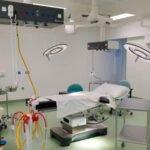Health leaders and charities are warning Scotland’s government that it “cannot be complacent” as breast cancer rates are projected to climb sharply in the next two decades. Latest figures show that about 71,000 women could be living with breast cancer by 2044 — a jump that’s forcing tough questions about screening, diagnosis and care.
With calls for faster action growing louder, the reality for patients and clinicians alike is a system that must adapt — or risk leaving thousands behind.
A Stark Projection Puts Pressure on Services
Public Health Scotland’s estimate of 71,000 women living with breast cancer within 20 years has jolted health advocates.
Nearly half of that rise comes from better survival rates — which sounds good — but it also means the system will have to support more women for longer.
Melanie Sturtevant from Breast Cancer Now says the numbers are “alarming”. She points out that too many women still endure anxious waits to be seen and diagnosed, which means cancers caught later and outcomes that could be worse.

Reviewing the Screening System — Again
This isn’t the first time Scotland’s screening programme has faced scrutiny. A major review back in 2022 painted a worrying picture: falling uptake, unequal access and an ageing workforce stretched thin.
One of its big ideas was a direct call-recall system — basically, an automatic reminder telling women when they’re due for screening. It sounds simple but hasn’t been rolled out nationwide yet.
• 17 recommendations made in 2022 review
• Direct call-recall and national workforce plan among them
• Uptake rates still patchy, especially in underserved groups
Who Gets Left Out?
Disparities are at the heart of this. Women from underserved groups — whether rural, poorer or from ethnic minorities — are less likely to be screened and more likely to face later diagnoses.
Dr Caroline Michie, a senior lecturer and cancer clinician, says tackling those inequalities is critical if Scotland wants to keep more women healthy.
One sentence stands out: “We cannot afford to be complacent.”
Bigger Numbers, Bigger Burden
The real-world impact is huge. Breast cancer is already the most common cancer among Scottish women. As survival improves, the system must care for more patients — but the number of oncologists and nurses hasn’t kept pace.
Dr Michie says that patients needing anti-cancer drug therapy or radiotherapy often wait longer than they should. And it’s not for lack of new treatments — there are more advanced, better-tolerated drugs now than ever. It’s the workforce that’s falling behind.
A snapshot from NHS Fife shows how demand is surging:
| Year | Patients Receiving Anti-Cancer Therapy |
|---|---|
| 2014 | 3,537 |
| 2024 | 6,814 |
Behind the statistics sits an old truth: the earlier breast cancer is caught, the better the outcomes.
That means awareness campaigns, easy-to-access appointments, and shorter waits for follow-ups after an abnormal scan. It also means more trained staff to read mammograms and deliver treatment quickly.
One breast cancer nurse said bluntly: “It’s not enough to tell people to get checked. You need a system ready to catch them when they do.”
Are Pledges Enough?
The Scottish government’s Cancer Action Plan promises to modernise breast screening and tackle waiting times. But three years on from the review, campaigners like Sturtevant say change is too slow.
Her plea: “Women deserve a prompt diagnosis, access to treatments and vital support. The alarming rise must not be met with more delays and disparities.”
Experts Call for Focus on People, Not Just Plans
For now, those on the frontline say that while survival is improving, Scotland can’t pat itself on the back yet.
The challenge is balancing new breakthroughs with the gritty reality of boots-on-the-ground healthcare — the nurses, radiologists, and oncologists who keep the wheels turning.
Dr Michie puts it plainly: “Novel treatments are brilliant. But they don’t matter if you can’t get them to patients in time.”

















